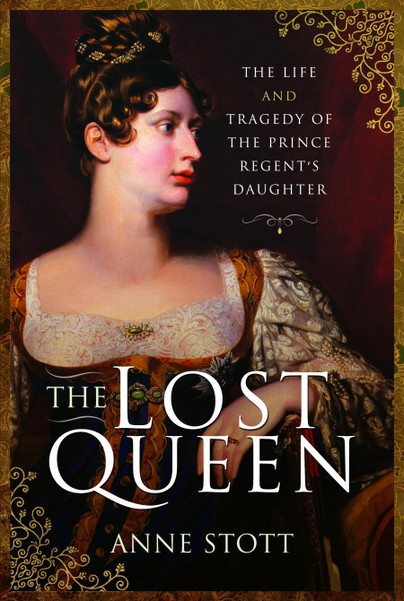
No one expected royal marriages to be happy, least of all George, Prince of Wales, who was already illegally married to his mistress Maria Fitzherbert. He only agreed to marry his first cousin because he had spiralling debts. His new bride, Caroline of Brunswick, had no choice in the matter. Women were mere diplomatic bargaining chips. Consent was not an issue. It was not a good match. On first meeting, George called for a glass of brandy. He said she stank. She thought he was fat.
Nevertheless they did their duty and Princess Charlotte, the ‘lost queen’ of the title, was born in 1796. They never lived together and they never ‘came together’ again.
What a terrible, lonely childhood poor Princess Charlotte had. Effectively she was a looked-after child, brought up by paid (and often reluctant) help and tutored by lofty bishops and scholars. She was simultaneously treated as both highly important – she was second in line to the throne – and worthless, a know-nothing girl with little understanding of the world (understanding she was prevented from acquiring because she was a girl, of course).
She was a gawky child. She sometimes made inappropriate remarks and had to be reminded to be more ladylike and not show her underfrillies as she climbed into carriages. She could be tempestuous (and sweetly contrite afterwards), funny, generous to the poor. Who could she trust to love her for herself? Certainly not her selfish immature parents and certainly not the staff who fussed over and criticised her.
I nearly cheered out loud when reading the chapter covering Charlotte’s teenage years. She might have been infuriating at times, but she was finding her voice. Her family did not necessarily think this was a good thing. ‘Self-opinionated to a great degree and holding every soul as cheap as dirt,’ was the verdict of an unamused Princess Elizabeth on her 15-year-old niece, but there was worse to come when Charlotte called off her engagement to William, Hereditary Prince of Orange. Charlotte accepted that her future probably lay in an arranged marriage but balked at being forced to leave England with her new husband, possibly never to return. She also dreamed of real romance and real love.
Dad swiftly ordered that she be confined at Cranbourne Lodge at Windsor where she would have to think about her behaviour, but before she could be taken off, she ran out into the street and hailed a cab to her mother’s house. She knew so little of real life that she gave the somewhat astonished driver ten guineas for his trouble. She returned to her father the next day, but she had made her point. The engagement was terminated.
Ordinary people, exhausted by long wars and economic strife, loved her as much as they disliked her profligate, corrupt father. When she did marry, in 1816, huge crowds poured in to London to cheer her and her bridegroom. Thwarted in a romance with Prince Frederick of Prussia, she had settled instead for handsome-but-poor Prince Leopold of Saxe-Coburg. It was a pragmatic choice on both sides but, somewhat to their surprise, they found a deep and genuine mutual love. Interestingly, years earlier Charlotte compared herself to Jane Austen’s fragile and emotionally uninhibited Marianne Dashwood in Sense & Sensibility, whose journey stretches from obsession with John Willoughby to lasting love with Colonel Brandon.
Charlotte’s happiness did not last long. On 6 November 1817 she died just a few hours just after delivering a stillborn son. And yes, I did weep in the final chapter, in which Stott takes us through about Charlotte’s last hours and the distracted grief of her young widower.
Bells were tolled across the country; theatres closed; shopkeepers dressed their windows in black cloth. Stott compares the nation’s grief to that felt for Lord Nelson and, 180 years later, for Princess Diana.
What kind of queen did we lose? A good one, I think. As a child Charlotte may have dismayed her tutors with her hopeless attempts to learn Latin, but she was bright and interested in other things. She took the initiative and informed herself comprehensively about history and politics. She was an excellent amateur musician. Ironically, her passing gave us another queen: after it was clear that George could not divorce Caroline and could not therefore produce any more heirs, his brothers got busy. Edward, Duke of Kent married Leopold’s sister Victoire and promptly died soon after leaving his daughter Victoria as the heir to the throne after the childless William IV. For Victoria, Charlotte was always shadowy presence. ‘What a dreadfully sad life my poor Cousin’s & Aunt’s was & and only 18 or 19 months of real happiness,’ she wrote in 1873, 36 years after she ascended the throne.
This perspicacious study of Charlotte’s short life is superb. Anne Stott is an accomplished and highly readable biographer whose earlier subjects have included William Wilberforce and Hannah More. She wears her research lightly – which is not to say that the book is anything less than scholastic (quite the opposite). Highly recommended.
The Lost Queen: The Life and Tragedy of the Prince Regent’s Daughter
by Anne Stott
Pen & Sword (2020)
Thank you to Pen & Sword for providing a copy of The Lost Queen for review.

Leave a Reply